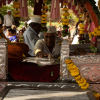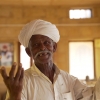Introduction
The age old tradition of transmission of stories from one generation to another is better known as oral tradition. It is much older than written literature and still plays a crucial role in the functioning of indigenous cultures and societies. Among the most prominent forms of oral narratives, folk songs stand out in importance as they characterise and depict the socio-cultural aspects of a particular society and the changes this society undergoes. This implies prevalence of a myriad musical styles and musical traditions whose nuances vary from place to place.
Tiwa tribe and their cultural heritage
The indigenous Tiwa tribe of Assam has a rich repository of cultural heritage which is largely oral. The Tiwas, popularly known as Lalungs of Assam, are one of the major native tribes of the state. They are mostly found in the plains of Nagaon, Morigaon hills of Karbi Anglong and Kamrup districts of Assam and the state of Meghalaya. The whole Tiwa tribe can be divided into two groups according to their living pattern—those who live in the hills are called hill Tiwas and those who are living in the plains are called plain Tiwas. Significantly the cultural traits and practices of the Tiwas of the plains and hills are different and distinct from each other (Thakur 1985).
The etymology of the word ‘Tiwa’ generally comes from ‘ti’ meaning ‘water’ and ‘wa’ meaning ‘superior’. According to legends, as the tribes landed on the plains following the course of the river Brahmaputra, they introduced themselves as the Tiwa.
Habitat
Plains Tiwa people are mostly inhabitants of Baropujia, Mayang, Bhurbandha, Kopahera area of Morigaon district; and Raha, Saragaon, Kothiatoli, Bhoksong area of Nagaon district .The topography and ecology of the plains and hills have influenced the Tiwa Tribe differently, resulting in distinct lifestyles of both in terms of food habits, dress, agricultural patterns etc. As mentioned by M. Deuri in his book Tiwa Jano Jati (1992), the cultural life of the plains Tiwa has been highly influenced by mainstream Assamese culture, thereby causing significant changes in their indigenous cultural traits.
Folk songs of the plains Tiwa tribe
The plains Tiwa have an array of folk songs sung on different occasions related to agricultural activities. Most of the folk songs of the Tiwa tribe are sung during different festivals and occasions. Some of the songs are accompanied by traditional dance. It is seen that dance is a part of every folk festival celebrated by the Tiwas. Tiwa people sing these folk songs at different occasions and also in their leisure times.
The most notable folk songs of the Tiwa Tribe are Barat songs (songs of the Barat Festival in Tetelia Kingdom of Kamrup District), Lai Hillai songs (traditional folk songs of love), Aarkura geet (another folk song form of the plains Tiwa tribe associated with agriculture), Ratisewa songs (devotional folk songs of Ratisewa religious ceremony) and Godalboria songs. Godalboria songs are called Pachorojia Godalboria. The term pachorojia denotes the five small kingdoms of the Tiwa tribe under Ahom rule in Assam. They are—Topakuchi, Baropujia, Sora, Saigarh and Mikir. The practice and performance of Godalboria songs are restricted to Tiwa tribes living within the Pachorojia area.
Like other folk songs of Tiwa Tribes, Godalboria songs too are rooted in agriculture. Differentiating upon performance, they can be categorized into two types: the first type are performed without dance and the second type is accompanied by dance moves. The occasion celebrated in the Godalboriya songs are mainly different stages of agricultural activities—beginning from tilling, sowing, till harvesting. Godalboriya songs are performed collectively in each stage as an expression of joy and merriment.
Content
The content of Godalboria songs comprise primarily chores of agrarian life and paddy fields, customs of the plains Tiwa, indigenous ideologies, tranquility of nature and scenic beauty, description of multihued hilly lanes of paddy fields and metaphorical adherence to nature. The most romantic component of Godalboria songs are the free and bold expressions of the element of love between young boys and girls. Every type of Godalboria song is replete with striking lyrics depicting quintessential love.
The songs are rich in melody. The melodious nature of the songs renders them as highly compelling. The songs can easily engage people with their appealing lyrics descriptive of agrarian life. They contain substantial amount of energy in terms of performance.
The lyrics describe agrarian life in the simplest manner. The words of the Godalboria songs are colloquial which are picked out of day to day conversations. To be precise, the prevalent lyrics of Godalboria songs are found to be entirely in colloquial Assamese.
For example:
Kaurir koliyao o ronge oi chenaiti
Kaurir oi koliya Rong
Pepar hure hunioo douri ahisu
Aaru nu ki abulikom
(The colour of crow is black, O my beloved, Colour of crow is black, I came running hearing the tune of Pepa [Horn]) (Bolai Senapati 2016, pg 160-65)
This is a type of Godalboria song which has a long melodious tune, and hence is generally not accompanied by dance moves. The language of the song is in colloquial Assamese and its tone is simple and conversational.
O hale o baiahilu o sonai halodhi aatite
Nangol thoi ahilu o tupot
Moinare Chuli Kusa Nigoniye Kutile
Morua telore gundhat
(O my beloved I have ploughed at Halodhi Aatite [name of place], placed the plough at Tup [name of place], the morua [a kind of oil] oiled hairs of our moina [baby] is chewed by rats). (Senapoti 2016, 160-65)
This is another example of a Godalboria song which is performed with dance. The scale of the song is low and performed with the beats of khram (drum), pepa (horn), and tal (cymbal).
The song simply illustrates day-to-day life of the Tiwa agrarian society in a manner blended with the element of selfless love. The component of love is pervasive in all forms of Godalboria songs. Moreover if we decipher the meaning of these songs attentively then there will be no coherent meaning to analyze, since songs are highly metaphorical. Often lines with no direct connection with the previous lines are added as comparisons with other discrete things, quite out of context.
In the second song illustrated above, the second line represents such a metaphor which is moina (a baby’s) hair us chewed by rats, which actually doesn’t directly correspond with the first two lines.
Transition from Tiwa to Assamese
As stated above, the lyrics of Godalboriya songs are found in Assamese language now and the words are very simple and authentic. Unlike the mainstream Assamese language which is greatly influenced by Sanskrit, the lyrics in these songs represent colloquial Assamese which is still used in places of middle and upper Assam.
Trying to trace the origin of the lyrics in the songs, it is found that the past two to three generations continue to sing Godalboria songs in Assamese language only. Elders of the Tiwa community opine that originally the lyrics of Godalboria songs were in Tiwa language as is evident from other folk songs practised by the plains Tiwa community whose lyrics are still in their native language. Probably, in due course of time, an intermixing and assimilation of the native language with mainstream Assamese culture resulted in the lyrics gradually being transformed into Assamese language.
Comparison with other folk songs
Apart from Godalboria songs, the Plain Tiwa community have some other rich folk songs and dances, which are performed on different occasions. The most notable are Barat songs, Lai Hilali Songs and Rati Sewa Geet, etc. Lai Hilali songs are also highly energetic and popular traditional songs of the Plain Tiwa community. These songs are performed with dance. Significantly, the lyrics of the current Lai Hilali songs are not purely Assamese. There exists a few Assamese words and rest are all Tiwa words.
Lole Lahoi Lolebahoi
La len heloya laye luki lo bai
La len heloya lai Lali lang lohe
Lo Bai Lali lang lohe lo bai
La len heloya laye luki lo bai
La len heloya lai
(Meaning: Dance, indulge in dance, dance into the tune slowly slowly)(Senapati 2016)
In case of prevalent Godalboria songs, the lyrics are purely in Assamese language. The obvious factor behind it is the proximity to mainstream Assamese culture and geographical location within Pachorojia Kingdom.
The Pachorojia link
Godalboria songs are termed as Pachorojia Godalboria songs since they are performed within five Tiwa kingdoms comprising Topakuchi, Baropujia, Sora, Khaigarh, and Mikir. They are very small in size and the boundary of each kingdom touches the other. They were under the great Ahom Empire as a subordinate kingdom paying tax revenues to the Ahom king regularly. Hence, the entire cultural gamut of the Pachorojia Kingdom is highly influenced by the Ahom Kingdom, and Assamese culture. Originally the Plain Tiwa tribe didn’t observe Bihu, as once they were living in hills and their hill counterparts still don’t observe it, as the hill Tiwas have their own distinct cultural festival.
The Plain Tiwa after migration from hills to the plains (especially Pachorojia Kingdom) had started to observe Bihu and other borrowed assimilated cultural forms . They did not completely renounce their indigenous culture though they embraced a number of other traits of the mainstream Assamese society. In the process of assimilation and intermixing, several new diverse cultural forms have developed over a period of time.
In this context, Godalboria songs are said to be a product of cultural infusion. It is very obvious that initially the language of Godalboria songs was primarily Tiwa. Over the centuries, Assamese continued to be the dominant language of the Pachorojia Kingdom resulting in a gradual disappearance of their ancestral language. The extinction of their language highly impacted their cultural expressions to be translated into more common and convenient language forms. At present Godalboria songs are widely performed in the Pachorojia Kingdom only in Assamese language.
Conclusion
Cultural transformation is an integral part of cultural development. Godalboria songs are one of the most valuable intangible cultural heritages of the Plain Tiwa community. Due to mechanisation of society and culture, such rich cultural heritage encounters challenges of extinction. The need of the hour is to ensure the preservation of Godalboria songs as a cultural heritage by providing exposure to the same through training to newer generations.
References
Thakur, G.C Sharma. 1985. The Lalungs. Assam: Tribal Research Institute.
Deuri, M. 1992. Tiwa Jono Jati.
Senapoti, Rupantar. ed. 2016. Bolairam Senapati Rosona Samagra.












